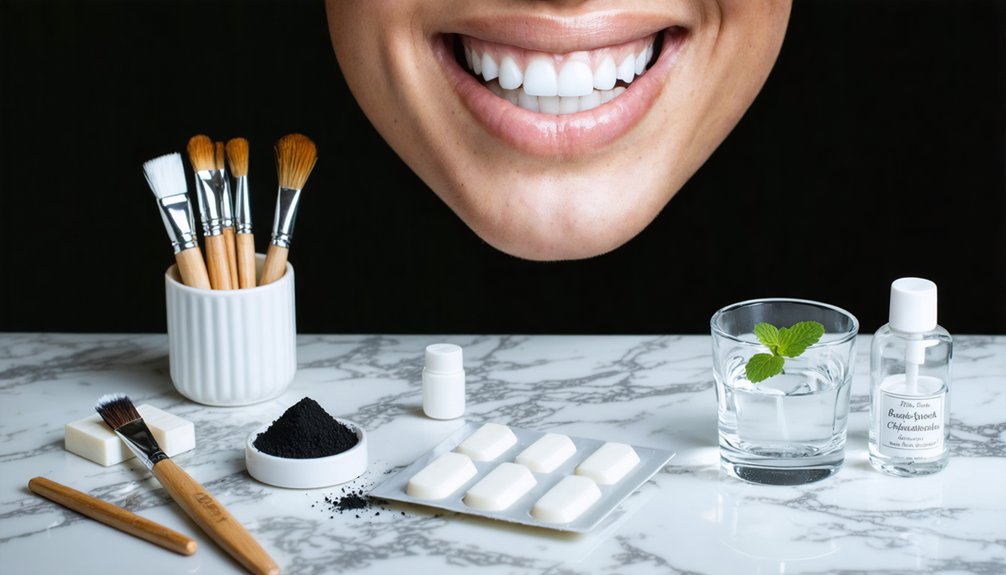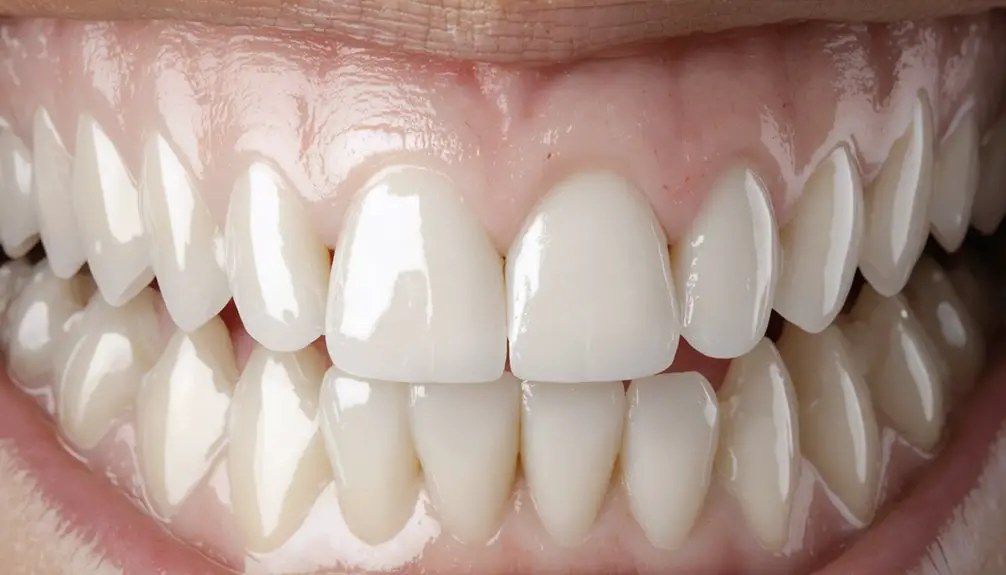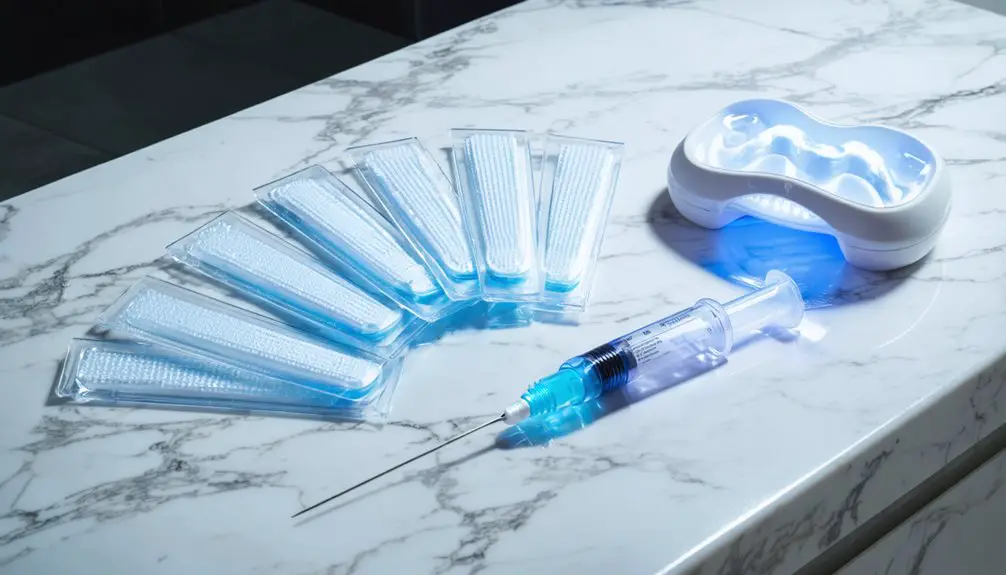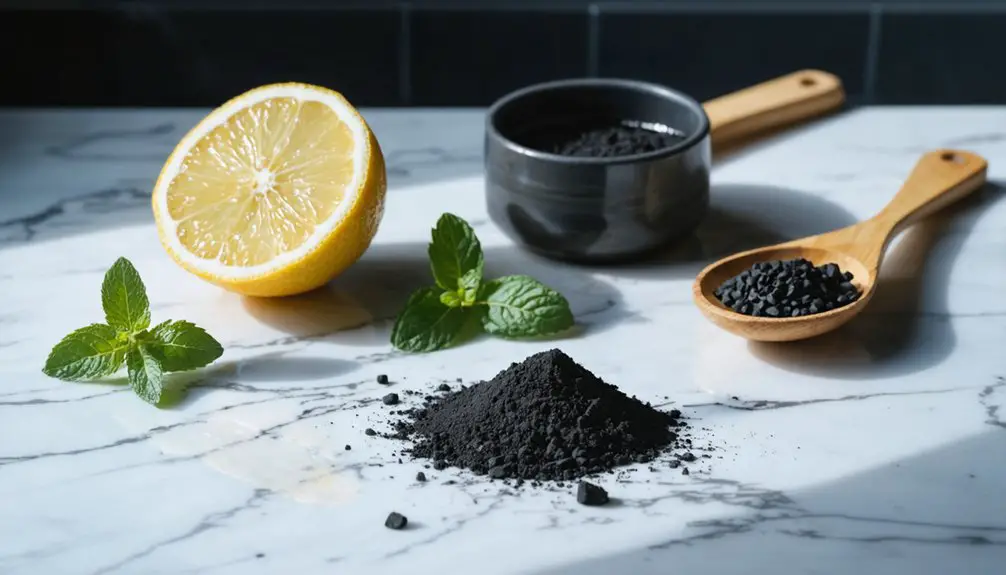To achieve successful teeth whitening, you’ll need a personalized approach based on your tooth color, sensitivity level, and lifestyle habits. Start with a professional evaluation to determine the best whitening method for your needs. Consider both in-office treatments for rapid results and at-home options for gradual improvement. Maintain proper oral hygiene, avoid staining foods, and use desensitizing products before treatment. Your path to a brighter smile depends on understanding these key factors.
Key Takeaways
- Schedule a professional dental evaluation to determine your tooth color and condition before selecting a whitening method.
- Choose between rapid in-office treatments or gradual at-home options based on your timeline and sensitivity concerns.
- Use desensitizing toothpaste before starting treatment and avoid hot/cold foods during the whitening process.
- Maintain results by avoiding staining foods, using straws for beverages, and implementing thorough oral hygiene practices.
- Plan regular touch-up treatments every 6-12 months and adjust treatment concentration based on your age and sensitivity level.
Understanding Your Starting Point: Evaluating Tooth Color and Condition
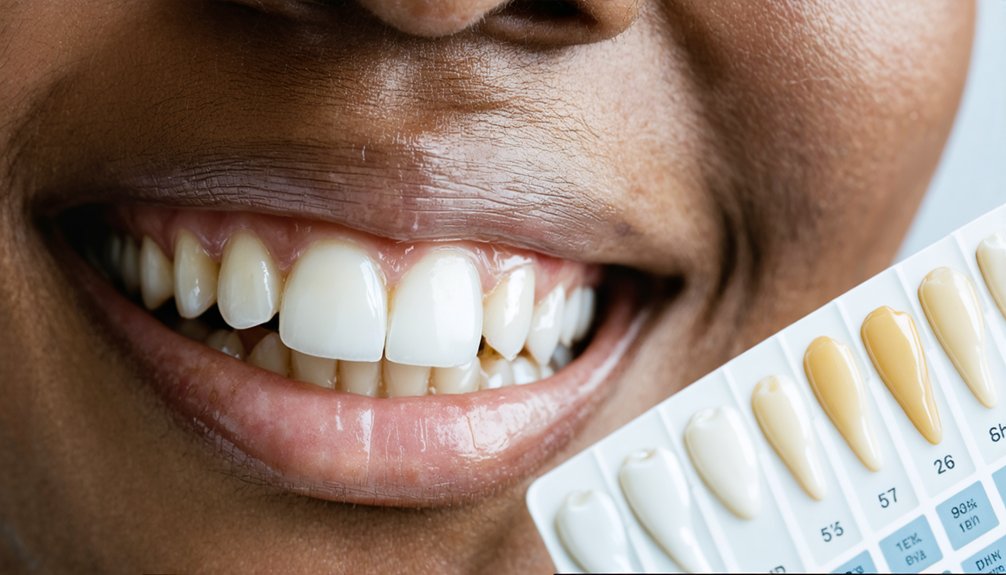
Before starting on any teeth whitening journey, you’ll need to establish a clear understanding of your current tooth color and condition. Schedule a professional evaluation, as your dentist can use advanced assessment methods like spectrophotometers or shade guides to determine your exact starting point.
Your tooth color evaluation will be most accurate for your front teeth, particularly the central incisors, due to their flat surfaces. Be aware that factors like existing dental work, surface texture, and previous staining can affect your assessment results. Digital instruments have demonstrated superior precision compared to traditional visual methods.
Your dentist will consider environmental conditions, especially lighting, to guarantee accurate color measurement. The VITA 3D-Master system has shown superior reliability in measuring tooth shades compared to other methods.
Remember that medications, dietary habits, and lifestyle choices can influence your tooth color, so share this information with your dental professional to develop the most effective whitening strategy for your needs.
Choosing the Right Whitening Method for Your Needs
When selecting a teeth whitening method, you’ll need to contemplate several key factors that influence both effectiveness and comfort.
Consider your whitening duration preferences, as professional in-office treatments deliver rapid results in about an hour, while at-home methods require weeks of consistent application. For optimal results, methods like KöR whitening incorporate custom-made trays that ensure even coverage of the whitening gel. At-home treatments typically use whitening strips that can be applied for 20-30 minutes daily.
Product effectiveness varies greatly, with professional treatments offering up to eight shades of improvement compared to moderate changes from over-the-counter options.
- Professional in-office whitening delivers dramatic results but may cause temporary sensitivity and requires a higher investment.
- Take-home custom trays balance effectiveness with comfort, offering controlled application and reliable outcomes.
- Combined treatments maximize initial results and provide excellent maintenance options.
- Over-the-counter products work best for mild staining or maintenance, with gentler but slower results.
Essential Pre-Treatment Steps for Maximum Results
Before starting any teeth whitening treatment, you’ll need a professional dental assessment to check for cavities, gum disease, or sensitivity issues that could affect your results.
To guarantee ideal whitening outcomes, schedule a thorough dental cleaning to remove tartar and surface stains that might interfere with the treatment’s effectiveness. Consider choosing between in-office treatment or at-home whitening options based on your needs and lifestyle.
To achieve the best results by maintaining impeccable oral hygiene and having pristinely clean teeth before beginning your whitening procedure. Dr. Suekert recommends avoiding staining foods and drinks for several days before your appointment.
Professional Assessment First
To achieve ideal teeth whitening results, a professional dental assessment serves as the cornerstone of any successful treatment plan. Your dentist will conduct a thorough examination of your teeth and gums, evaluate your current shade, and discuss your whitening expectations.
This professional evaluation guarantees you’ll receive the most effective and safest treatment tailored to your specific needs. During your assessment, dentists carefully check for intrinsic and extrinsic stains to determine the most appropriate whitening approach. Under the guidance of Dr. Aggarwal, you’ll receive expert support throughout the entire whitening process.
- You’ll gain confidence knowing your teeth and gums are healthy enough for whitening treatment
- You’ll understand exactly what results you can achieve, avoiding disappointment
- You’ll receive a customized treatment plan that addresses your unique dental characteristics
- You’ll minimize potential risks and sensitivity issues through expert oversight
This initial assessment helps create a precise roadmap for your whitening journey, guaranteeing ideal results while protecting your oral health.
Starting With Clean Teeth
Since proper teeth cleaning serves as the foundation for successful whitening, taking the right preparatory steps will considerably boost your treatment’s effectiveness. Your pre-whitening routine should begin with thorough brushing and flossing to remove plaque and debris that could interfere with the whitening gel’s performance.
Start by maintaining consistent oral hygiene in the days leading up to your treatment. Use a soft-bristled toothbrush with fluoride toothpaste, and avoid harsh scrubbing that might irritate your gums. Moisture reduces gel efficiency, so ensure teeth are completely dry before applying whitening products. Dental issues like cavities must be treated before any whitening procedure.
You’ll want to increase your water intake while avoiding staining substances like coffee, tea, and red wine. If you’re planning professional treatment, consider scheduling a dental cleaning first to remove stubborn tartar.
Remember to floss carefully between teeth, as trapped debris can lead to uneven whitening results.
Managing Sensitivity During the Whitening Process
While teeth whitening can create a brighter smile, many people experience temporary sensitivity during the process. You can minimize discomfort by understanding common sensitivity triggers and taking preventive steps.
Start using desensitizing products like specialized toothpaste two weeks before treatment, and choose whitening formulas with lower peroxide concentrations for gentler results.
- Avoid hot and cold foods or drinks for 24 hours after treatment to prevent painful nerve reactions.
- Use proper-fitting trays or strips to keep whitening gel from irritating your gums.
- Apply desensitizing gel before whitening treatments to protect exposed dentin.
- Consider take-home kits instead of in-office treatments for more gradual, comfortable results.
If sensitivity persists, maintain room temperature foods and continue using protective oral care products until symptoms subside.
Daily Habits That Support Long-Lasting Results
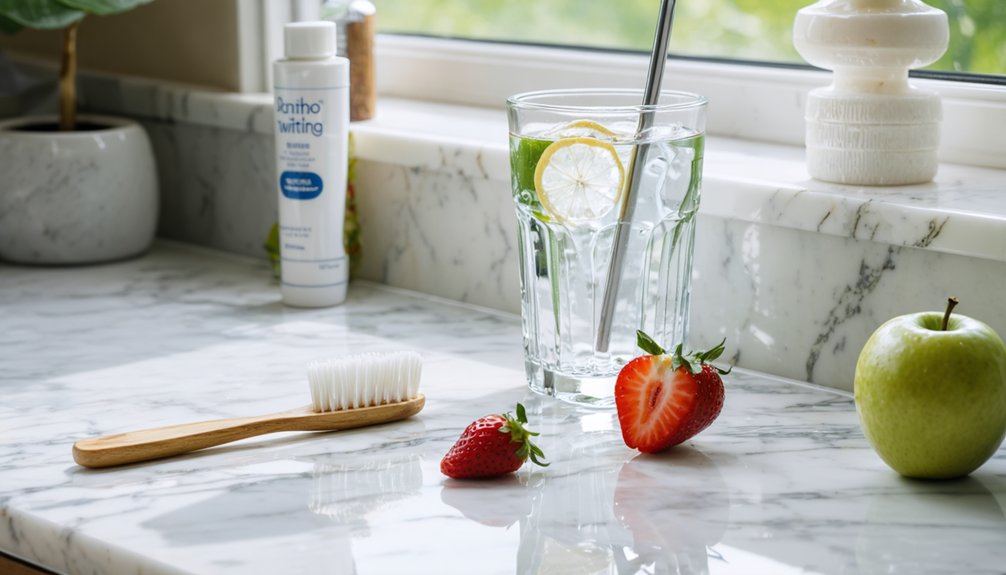
Your food and beverage choices play a vital role in maintaining your teeth’s whiteness, so opt for less pigmented foods and use a straw when drinking staining beverages.
You’ll preserve your bright smile by brushing correctly twice daily with whitening toothpaste, using gentle circular motions and paying special attention to all tooth surfaces.
Remember to wait at least 30 minutes after consuming acidic foods before brushing to protect your enamel while maintaining ideal whitening results.
Smart Food Choices Matter
Making strategic food choices plays an essential role in maintaining teeth whitening results long-term.
You’ll want to incorporate natural abrasives from crunchy fruits and vegetables while protecting your enamel health through smart timing.
Consider how certain foods can actively support your whitening goals through mechanical cleaning and chemical processes.
- Enjoy apples, celery, and carrots as nature’s toothbrushes – they’ll scrub away plaque while stimulating beneficial saliva production.
- Choose aged cheeses and yogurt to strengthen enamel and provide gentle whitening through lactic acid.
- Wait 30 minutes after consuming acidic fruits before brushing to protect your enamel.
- Stay hydrated with water throughout the day to rinse away staining agents and maintain ideal oral pH balance.
Brushing Techniques For Whiteness
Beyond smart food choices, proper brushing techniques form the foundation of a successful teeth whitening routine.
You’ll want to brush twice daily for two minutes each session, using gentle circular motions with a soft-bristled toothbrush. Pair your brushing with fluoride toothpaste to protect your enamel while working toward a brighter smile.
To maximize whitening effectiveness, combine your regular brushing routine with specialized tools like whitening toothpaste containing baking soda. An electric toothbrush can enhance plaque removal and provide more consistent results.
Remember not to overbrush, as this can wear down enamel and increase sensitivity. While brushing alone won’t dramatically change your teeth’s natural color, proper technique helps maintain results from professional whitening treatments and removes surface stains that dull your smile.
Professional vs. At-Home Treatment Options
When deciding between professional and at-home teeth whitening treatments, understanding the key differences in effectiveness, safety, and convenience becomes essential.
Professional treatments offer rapid results with higher peroxide concentrations, achieving up to 10 shades lighter in just 30-60 minutes. While the cost comparison shows professional treatments are pricier ($300-$1000), they provide immediate treatment effectiveness under expert supervision.
Professional whitening treatments deliver dramatic results fast, with expert oversight ensuring both safety and effectiveness – though they come at a premium price.
At-home options, though slower, can achieve similar results over time at a lower cost.
- You’ll experience faster, dramatic results with professional treatments if you’re preparing for an important event or presentation.
- You’ll save money with at-home treatments while still achieving professional-level results if you’re patient.
- You’ll benefit from expert supervision and reduced health risks with professional treatments.
- You’ll have more flexibility and control over sensitivity issues with gentler at-home options.
Age-Specific Considerations for Teeth Whitening
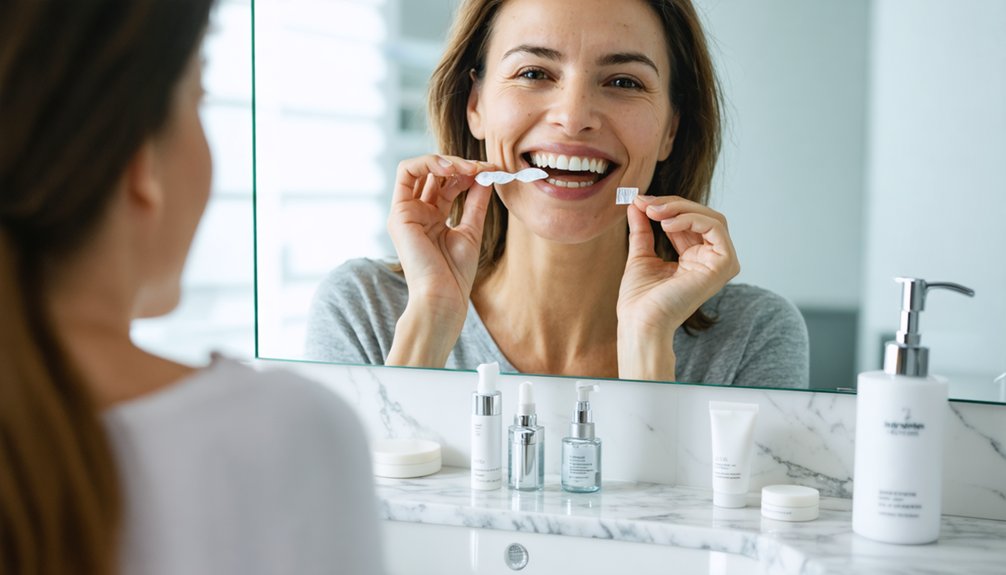
As teeth whitening grows increasingly popular across age groups, understanding the age-specific factors becomes essential for safe and effective treatment.
Before pursuing any whitening procedure, you’ll need to take age limitations into account, particularly if you’re treating younger patients. Wait until all permanent teeth have erupted, typically around age 14-16, before initiating treatment.
Enamel thickness plays a vital role in determining safety. Children and adolescents have thinner enamel, making them more susceptible to sensitivity and damage from whitening agents.
If you’re working with patients under 16, recommend alternatives like cosmetic bonding for severe discoloration. For teens with all adult teeth, choose lower-concentration products and maintain close supervision.
Always conduct a thorough dental assessment to identify any contraindications before proceeding with whitening treatments.
Maintaining Your Bright Smile: Follow-Up Care Strategies
The long-term success of teeth whitening depends on proper follow-up care and maintenance strategies.
Despite common misconceptions, maintaining your bright smile isn’t just about avoiding coffee and red wine. You’ll need to adopt thorough care habits that protect your investment and prevent whitening myths from derailing your results.
- Implement a targeted post-whitening diet by choosing lighter-colored foods and using straws for beverages that could stain.
- Monitor and address sensitivity issues promptly, distinguishing between normal reactions and concerns that need professional attention.
- Schedule regular touch-up treatments every 6-12 months, coordinating with your dental provider’s recommendations.
- Practice meticulous oral hygiene, including gentle brushing techniques, daily flossing, and proper tongue cleaning to maintain ideal results.
Frequently Asked Questions
Can Teeth Whitening Remove White Spots or Calcium Deposits on Teeth?
No, teeth whitening won’t remove white spots or calcium deposits. You’ll need specialized treatments like ICON resin infiltration since white spot causes and calcium deposit treatments require addressing underlying enamel irregularities.
Will Whitening Treatments Affect Existing Dental Work Like Crowns or Veneers?
Whitening treatments won’t change the color of your crowns or veneers since these dental restorations aren’t permeable. Due to this treatment compatibility issue, you’ll need professional replacement if color matching becomes necessary.
Is It Safe to Whiten Teeth While Pregnant or Breastfeeding?
Like many expectant moms, you’ll want to wait until after pregnancy for whitening safety reasons. While breastfeeding, you can safely whiten your teeth with professional supervision, as treatments won’t affect your baby.
How Soon After a Dental Cleaning Should I Wait to Start Whitening?
You can start whitening immediately after cleaning if your gums aren’t inflamed. Timing factors like gingivitis may require a few days’ wait, but cleaning benefits make whitening more effective right away.
Can Certain Medications Affect the Success of Teeth Whitening Treatments?
Yes, your medication types can greatly impact whitening efficacy. Tetracycline antibiotics cause intrinsic stains that resist whitening, while medications like chlorhexidine and antipsychotics create surface stains affecting treatment success.
References
- https://www.alpinewhite.com/en/article/teeth-whitening-statistics/
- https://www.thedentalspajersey.com/blog/teeth-whitening-statistics-2024
- https://pmc.ncbi.nlm.nih.gov/articles/PMC10302806/
- https://www.loudfamilydentistry.com/blog/teeth-whitening-related-statistics-on-effectiveness-and-sensitivity-incidence
- https://pmc.ncbi.nlm.nih.gov/articles/PMC4058574/
- https://auraglow.com/blogs/articles/teeth-whitening-facts-statistics
- https://www.mouthhealthy.org/all-topics-a-z/teeth-whitening
- https://www.ada.org/resources/ada-library/oral-health-topics/whitening
- https://pmc.ncbi.nlm.nih.gov/articles/PMC10526998/
- https://thescipub.com/pdf/crdsp.2023.8.16.pdf
